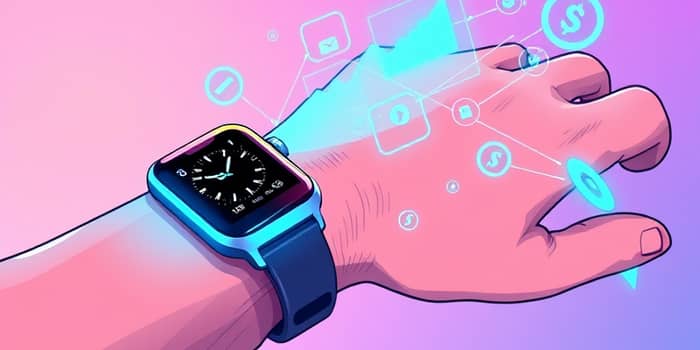In an era where every second counts, wearables have evolved beyond fitness tracking to redefine how we manage money. From jet-setting executives to everyday commuters, devices on the wrist now offer always on financial connectivity, turning simple gestures into secure transactions and instant insights.
Market Landscape and Growth Trajectory
The global wearable tech market is on a steep upward curve. Forecasts project growth from $29.12 billion in 2025 to $39.19 billion by 2029 at a compound annual growth rate (CAGR) of approximately 7.7%. Other analyses anticipate a total surge of $99.4 billion between 2025 and 2029 at a CAGR of 17.3%.
Financial institutions and fintechs are pouring resources into this fast-growing sub-market. Over 3,900 startups have emerged with 27,000 funding rounds averaging $25.7 million per deal. Leading investors like General Atlantic, SoftBank Vision Fund, and Tiger Global underscore the sector’s appeal.
Devices and Applications in Finance
The wearables landscape now blends style, health, and money management. Beyond the familiar smartwatches, a suite of form factors empowers users to pay, track, and authenticate with ease.
- Smartwatches (Apple Watch, Samsung Galaxy Watch).
- Fitness trackers and smart rings.
- “PayWear” bands and tokenized patches.
- Hearables with built-in payment chips.
From tap-to-pay at cafés to checking account balances mid-run, these tools deliver a seamless, hands-free payment experience. NFC, QR codes, and Bluetooth LE power contactless payments, while integrations with PayPal, Venmo, Apple Pay, and Google Pay extend capabilities across ecosystems.
Security and Privacy: Fortifying On-Wrist Transactions
Trust is paramount when money moves at a gesture. Emerging standards and robust design principles ensure wearables safeguard user data and financial assets.
- Biometric authentication: fingerprint, voice recognition, and ECG monitoring.
- Tokenization and encryption for every transaction.
- Two-factor authentication via paired smartphones.
- Geo-fencing and proximity-based security layers.
Platforms rely on contactless, tokenized payment security to replace sensitive information with unique digital tokens. Compliance with global banking regulations and secure on-device storage further reinforce user confidence.
User Experience and Consumer Behavior
Adoption is lightning-fast among digital natives. Over 40% of Millennials and Gen Z express willingness to pay with wearables, valuing speed and convenience over traditional cards. Wearables offer:
- Instant transaction alerts that flag suspicious activity.
- On-demand spending summaries and budgeting nudges.
- Customizable dashboards and notification preferences.
By empowering personalized financial insights and alerts, wearables transition from novelty gadgets into trusted everyday companions. The ability to glance at one’s wrist for an up-to-the-second balance or an outlier purchase report drives deeper engagement.
Technological Drivers Shaping the Future
Several cutting-edge developments underpin the next chapter of wearable finance:
Advanced sensor arrays detect user context—location, heart rate, and motion—to enable frictionless interactions. Improvements in edge computing and AI allow on-device fraud detection and savvy spending recommendations without cloud dependence.
Emerging standards in 5G and NFC boost transaction speed and reliability, even in low-connectivity zones. Meanwhile, cross-platform API integrations unlock seamless data exchange between banking apps, fitness trackers, and lifestyle platforms.
Global Adoption and Industry Use Cases
Regionally, Europe and APAC lead consumer uptake, while North America focuses on innovation pilots. Banks and retailers are collaborating with device makers to deploy diverse use cases:
- Westpac Bank (Australia) issues “PayWear” bands for high-frequency, low-value transactions.
- Nordea Bank (Nordics) partners with smartwatch brands for integrated payment solutions.
- Premier Bank (Somalia) leverages tokenized patches to bring digital payments to underbanked populations.
Retailers experiment with smart badges and rings for checkout-free shopping and personalized in-store offers, blending loyalty programs with on-the-spot analytics.
Benefits, Challenges and Future Outlook
Wearable fintech delivers a spectrum of benefits that appeal to both users and institutions:
- Faster, more convenient daily purchases and payments.
- Enhanced security through advanced authentication.
- Integration with health and wellness incentives.
- Increased customer engagement and loyalty.
Yet challenges remain. Rapidly evolving cyberthreats demand continuous security upgrades, while counterfeit devices threaten consumer trust. The ecosystem’s fragmentation—multiple platforms, disparate protocols—hinders seamless standards adoption. Moreover, US adoption trails Europe and Asia, though rising consumer demand signals an upward trend.
Looking Ahead: Wearables as Financial Hubs
The next wave of innovation will transform wearables into full-fledged banking interfaces. Imagine on-wrist investment dashboards, AI-driven savings coaching, and spend-and-save programs that fuse wellness metrics with financial incentives. Cross-sector collaborations between insurers, banks, and health platforms will give rise to holistic “finwellness” products that reward positive behaviors.
As device variety expands—smart rings, patches, even clothing-embedded chips—the boundary between finance and everyday life will blur further. By 2030, wearables could serve as primary payment instruments for billions, empowering instant money management with unmatched convenience and security.
The revolution is already underway. With strategic partnerships, relentless innovation, and user-centric design, the era of wearables delivering finance at your fingertips is not just a vision—it’s the next reality.
References
- https://www.360iresearch.com/library/intelligence/banking-wearable-devices
- https://www.growingprotechnologies.com/blog/wearable-tech-in-fintech-secure-payments-and-authentication-on-the-go/
- https://www.pcbb.com/bid/2025-07-23-are-wearable-payments-back-in-style
- https://www.startus-insights.com/innovators-guide/wearable-technology-industry-report/
- https://www.debutinfotech.com/blog/wearable-app-development-guide
- https://www.prnewswire.com/news-releases/wearable-technology-market-to-grow-by-usd-99-4-billion-2025-2029-driven-by-wearable-devices-popularity-for-payments-report-highlights-ai-driven-trends---technavio-302360498.html
- https://www.fintechfutures.com/press-releases/wearable-payment-devices-strategic-business-report-2025-2030-revenues-to-exceed-146-billion-by-2030-with-enhanced-security-features-strengthening-market-trust
- https://www.fintechfutures.com/wealthtech/wide-application-for-wearables-in-financial-services-industry










